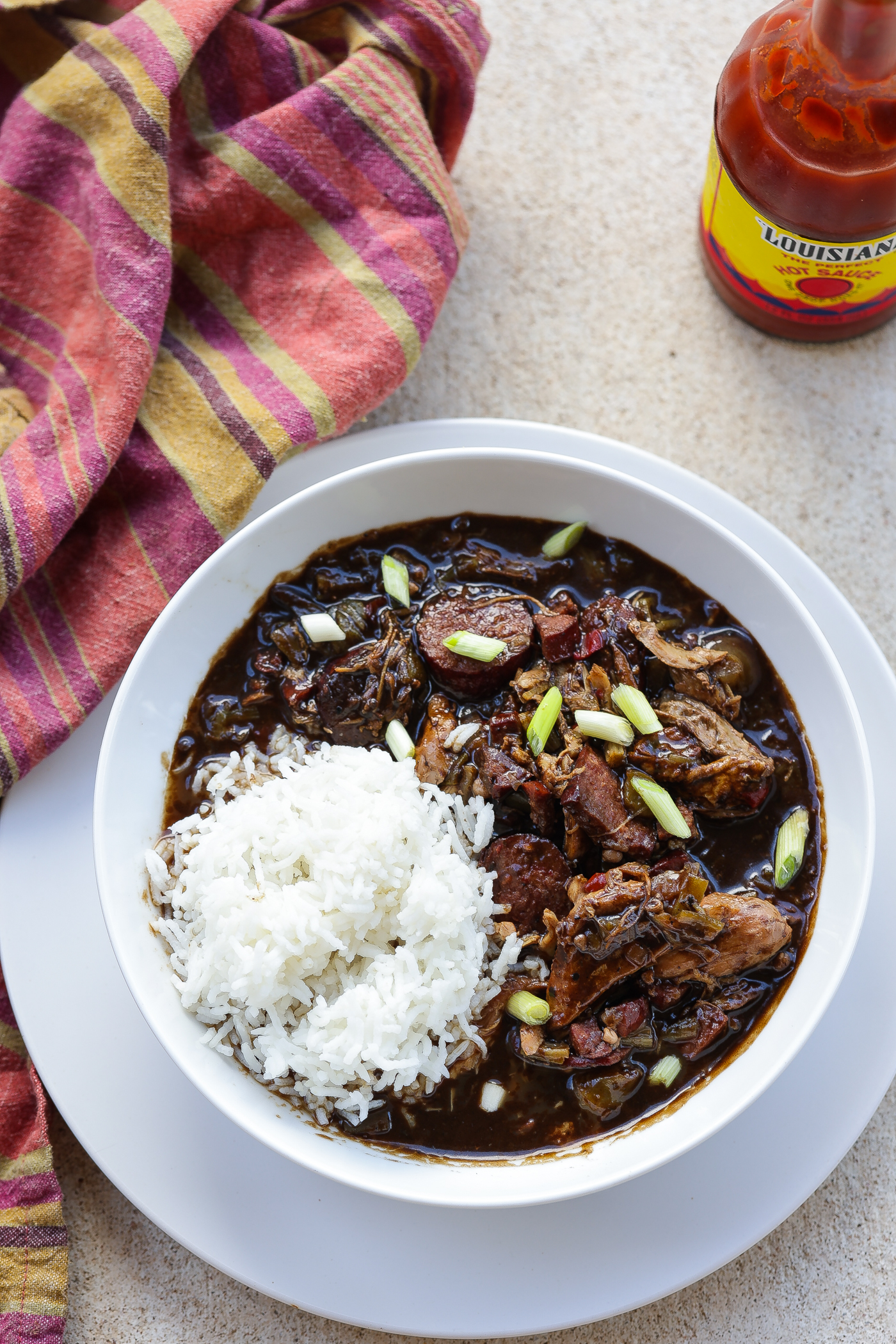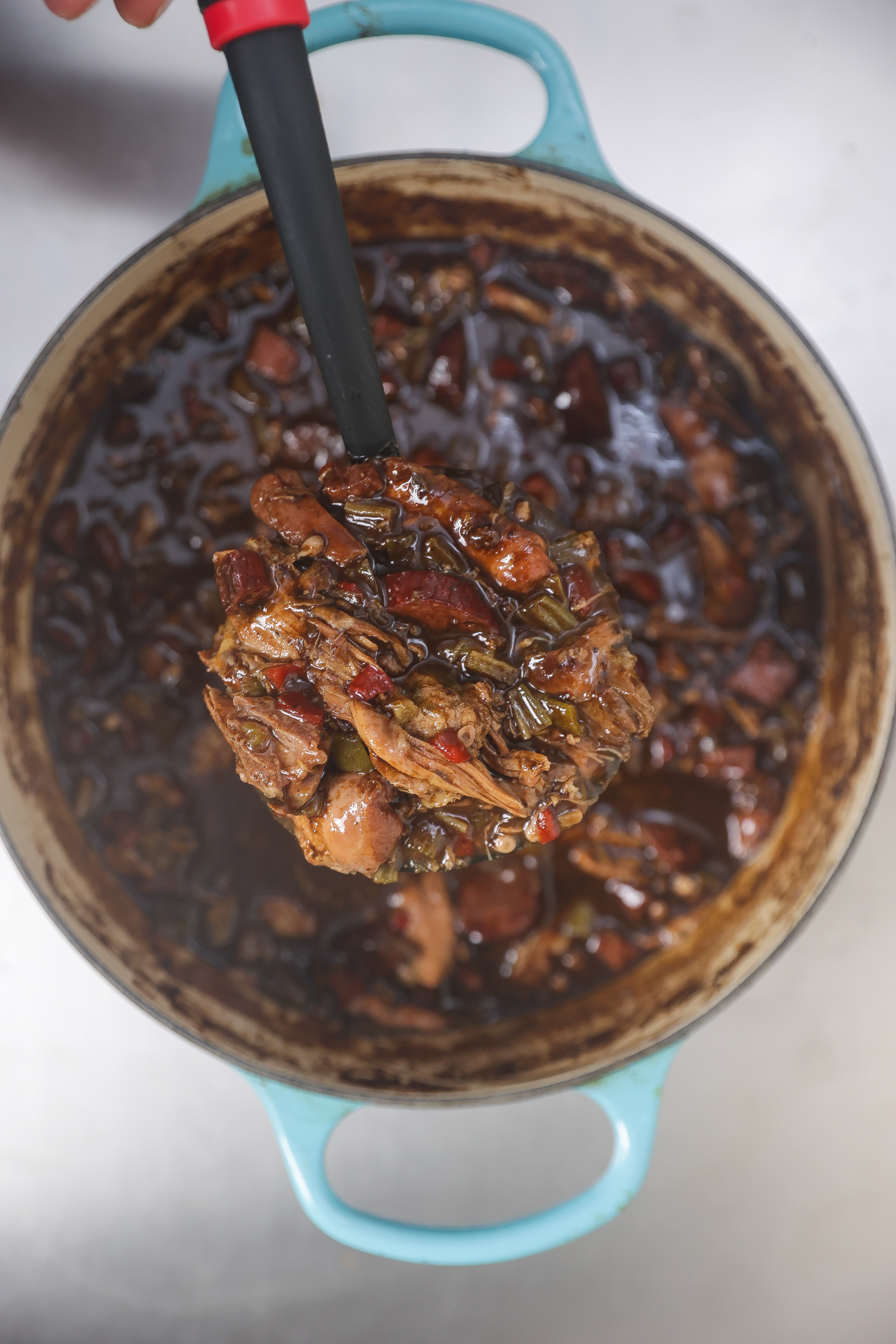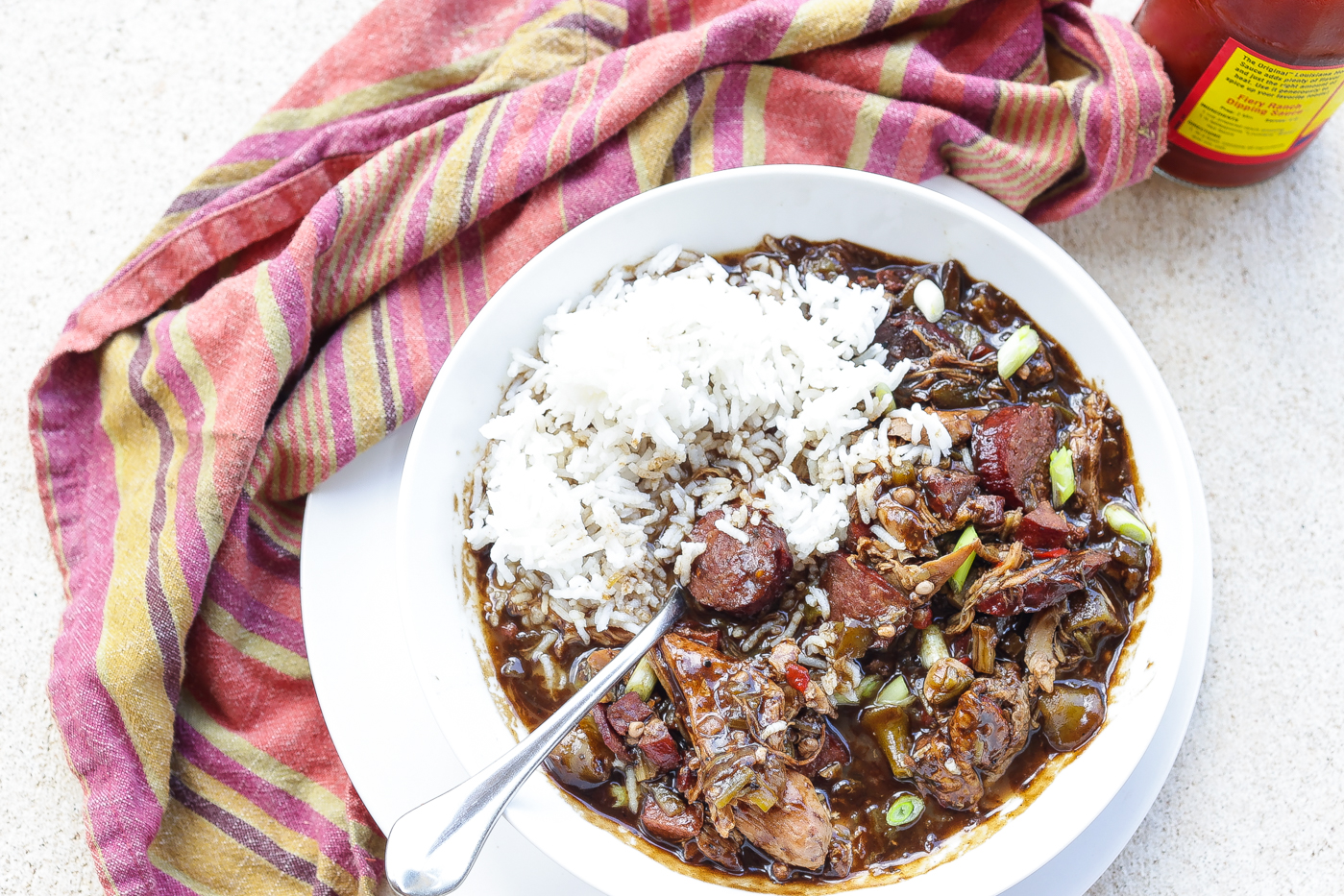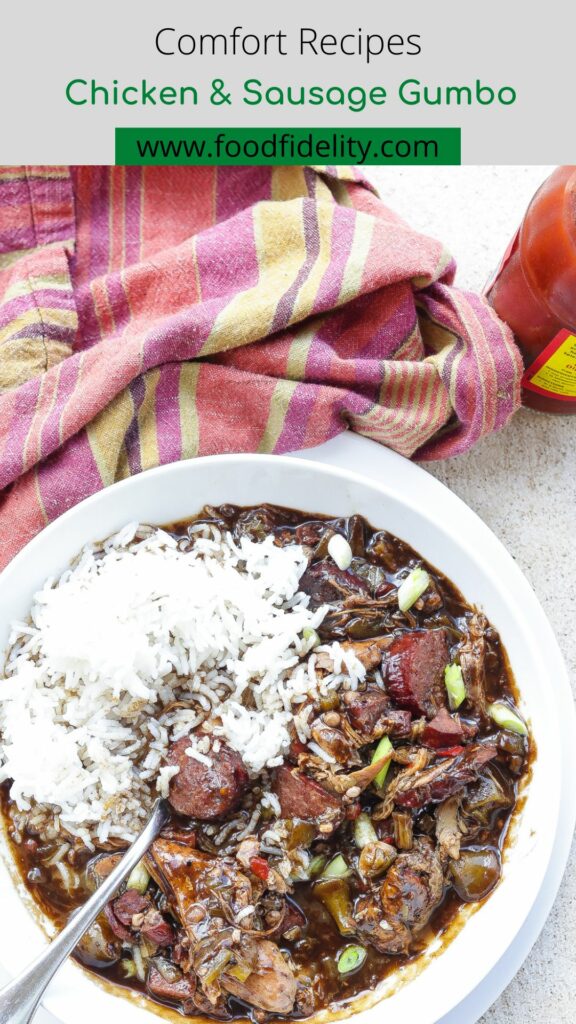This post may contain affiliate links via Amazon's affiliate advertising program. See privacy policy
Related Posts:
- Duck Gumbo
- Gumbo Z'herbes
- Shrimp and Okra Gumbo
- Instant Pot Gumbo
Hey there, flavor nerds! Get ready to embark on a culinary adventure that's going to make your taste buds groove and your senses dance – we're diving into the soulful world of Chicken and Sausage Gumbo.
Picture this: a rich, velvety roux setting the stage, a symphony of Cajun spices tuning up in the background, and the star players – succulent chicken and savory sausage – taking center stage. This isn't your average gumbo; it's a flavor journey curated for those who appreciate the artistry of taste.
So, turn up the heat, let those aromatic notes blend like a DJ's seamless mix, and get ready to experience a Chicken and Sausage Gumbo that's not just a dish but a celebration of flavor. Let's cook up a storm and make your taste buds dance!
Why Is Gumbo Such A Big Deal
Gumbo, a dish with roots deeply intertwined in the rich cultural tapestry of Louisiana, stands as a symbol of the region's diverse heritage and culinary prowess. Its origins can be traced back to West African, French, Spanish, and Indigenous influences, creating a melting pot of flavors and techniques.
Gumbo represents more than just a delicious meal; it embodies the history of a people and the evolution of their traditions. In Louisiana, the preparation of gumbo is a communal affair, passed down through generations, fostering a sense of belonging and shared identity. The dish's ability to adapt to local ingredients and preferences reflects the resilience and resourcefulness of the communities that have cherished it for centuries.
Whether served in a home kitchen or at a festive gathering, gumbo continues to be a culinary ambassador, inviting individuals to savor the unique blend of cultures that defines Louisiana's vibrant heritage.

Beats and Eats (music to pair with Chicken and Sausage Gumbo)
Immerse yourself in the soulful vibe of PJ Morton's "New Orleans Girl" as you savor the rich warmth of a steaming bowl of Chicken and Sausage Gumbo. Let the rhythmic melody mirror the flavorful dance of tender chicken, savory sausage, and the essence of Creole spices. With each note, feel the spirit of New Orleans come alive in your kitchen, blending the musical and culinary traditions that make both the song and the gumbo truly unforgettable.
What Is A Roux?
Alright, party people, let me drop some culinary beats on you! Now, imagine you're in the kitchen, and you're about to lay down the base for an epic flavor track. What you need is a 'roux' – it's like the DJ of your cooking game.
Picture this: equal parts butter and flour hitting the sizzling turntables, cooking up a smooth, silky vibe. We're talking about that magical moment when the fat and flour come together, dancing in the heat, creating a thick, flavorful mix. The longer you let it spin, the darker it gets, bringing out those deep, soulful tones.
So, in the world of cooking, a roux is your secret sauce, the maestro behind the scenes, setting the stage for a flavor symphony that'll make your taste buds groove. Get ready to elevate your culinary tracks with the magic of a perfectly crafted roux!
What Is Best Type of Sausage for Gumbo
The best type of sausage for gumbo is typically Andouille sausage. Andouille is a smoked sausage with French and German origins, and it has become a staple in Louisiana Creole and Cajun cuisine. This sausage is known for its robust flavor, which comes from a mix of pork, garlic, pepper, onions, and other seasonings. The smokiness of Andouille adds a distinctive and savory element to gumbo, complementing the rich flavors of the dish.
If you can't find Andouille sausage, another good option is a high-quality smoked sausage. Look for sausages with a good balance of spices and a robust smoky flavor to enhance the overall taste of your gumbo. While other sausages can work in a pinch, Andouille is the traditional and preferred choice for an authentic and flavorful gumbo experience. Here are a few options below:
Smoked Sausage
Flavor: Mildly smoky with savory undertones
Texture: Firm but smooth
If you can't find andouille, a good alternative is smoked sausage. While not as spicy or bold as andouille, smoked sausage still provides a delicious smoky flavor that complements the hearty richness of gumbo. You can find a variety of smoked sausages made from pork, beef, or a blend of meats. Some even come with added spices like paprika, garlic, or herbs that work well in gumbo.
Smoked sausage is widely available, making it a convenient option for those who don't have access to authentic andouille. It’s perfect if you’re looking for a milder sausage that still contributes a smoky depth to your dish without overwhelming other flavors.
Best for: All types of gumbo, especially if you prefer a less spicy option.
Kielbasa
Flavor: Mild, garlicky, and slightly smoky
Texture: Firm and smooth
Kielbasa, a Polish sausage, is another viable option for gumbo. It’s typically made from pork and seasoned with garlic and other spices. While it’s not native to Southern cooking, its mild smokiness and garlicky flavor can still work well in a gumbo, especially if you’re aiming for a less spicy version of the dish.
Kielbasa is readily available and offers a firm, smooth texture that holds up nicely when simmered in the gumbo broth. Although it lacks the heat of andouille, it adds a rich, savory flavor to the dish.
Best for: Milder gumbos or those that feature a variety of items like chicken and shrimp.
Turkey Sausage
Flavor: Lightly seasoned, mild, and slightly smoky
Texture: Lean and firm
For a lighter option, turkey sausage can be used in place of traditional pork sausages in gumbo. Turkey sausage is leaner than pork, making it a good choice for those who want a lower-fat version of the dish. While it doesn’t pack as much flavor as andouille or smoked pork sausage, you can find turkey sausage varieties that are seasoned with similar spices, providing a mild, smoky flavor.
Turkey sausage works best in gumbo if you’re looking for a lighter meal or want to reduce the fat content without sacrificing the hearty texture that sausage provides.
Ingredients Needed To Make Chicken and Sausage Gumbo
- Chicken:
- Whole Chicken legs (chicken thighs and legs attached)
- Sausage:
- Andouille sausage -Andouille sausage boasts a robust and smoky flavor profile, characterized by a harmonious blend of pork, garlic, onions, pepper, and a signature blend of Cajun spices. Andouille's bold and complex taste makes it a key player in Cajun and Creole cuisines, adding depth and authenticity to dishes like gumbo and jambalaya.
- Vegetables
- Yellow onion - Offers a sweet and savory taste when cooked, contributing to the overall richness.
- Red Bell pepper - add a sweet and slightly fruity flavor to gumbo. When sautéed or simmered, the natural sugars in the red bell peppers caramelize, enhancing their sweetness.
- Green Bell Pepper - Adds a sweet and slightly tangy note.
- Celery - Adds a subtle earthiness and a hint of herbaceousness.
- Okra - When cooked, okra develops a slightly earthy and mildly sweet taste with a hint of nuttiness.
- Garlic Cloves - contribute a pungent and savory flavor to gumbo. When minced and sautéed, garlic releases aromatic compounds that add depth and complexity to the dish. The flavor profile of garlic includes a combination of earthiness and a subtle sweetness, especially when cooked to a golden brown.
- Dark Roux:
- All-purpose flour
- Vegetable oil or unsalted butter
- Broth:
- Chicken broth (homemade or store-bought)
- Creole Seasoning:
- Bay leaves
- Dried Thyme - Adding dried thyme to gumbo contributes an herbaceous and slightly floral element that enhances the overall flavor profile of the dish.
- Smoked Paprika - The smokiness of the paprika complements the other savory and robust elements in the gumbo, especially if you're aiming for a richer flavor profile. It can add an additional layer of complexity, contributing to the overall depth and warmth of the dish.
- Garlic Powder
- Cayenne pepper (adjust to taste) - optional depending on taste preferences for heat
- Kosher Salt
- Black Pepper
- Worcestershire Sauce - Adding Worcestershire sauce to gumbo enhances the flavor profile by contributing a complex blend of savory, tangy, and umami notes. Worcestershire sauce contains ingredients such as anchovies, tamarind, garlic, onions, molasses, and various spices. This combination adds depth and richness to the gumbo, intensifying the overall savory and umami elements.
- Hot Sauce (optional)
- Garnish:
- Fresh parsley
- Sliced Green onions
How To Make Gumbo
For the Chicken
Mix dry seasonings together in a small mixing bowl. Set aside.
Season the chicken legs with about two tablespoons of creole spice mix. Let sit refrigerated for at least 30 minutes. Remove from the fridge and allow to reach room temperature.
Heat cast iron skillet over medium heat. Add some oil then add the chicken skin side down. Render the fat from the thighs. To help with rendering add weight either with a smaller heavy skillet or plate. Flip and repeat until both sides are well browned. Set chicken aside. Reserve the rendered fat for making the roux.
Using two forks or your hands pull chicken from the bones and shred into strips.
For the dark brown roux
Heat the skillet (containing the rendered fat). Add the flour to the rendered fat. Add some additional oil if necessary to get to a 1:1 ratio fat to flour. Stir often to prevent burning. Cook until roux is a dark chocolate color. For a faster, easier way to make your roux recipe you can bake in the oven which is what I do often.
Add diced onions, mix well and cook until onions caramelize. Add green peppers and celery sauteing for 2-3 minutes. Mix well.
Make The Gumbo
In a large dutch oven cook sausage, red bell peppers, and minced garlic. Add roux mixture, Worcestershire sauce, hot sauce, half the remaining spices, bay leaf, and chicken stock. Add the chicken back. Mix well with wooden spoon and simmer covered for about 1 hour stirring occasionally.
Remove the cooked chicken and pull chicken meat away then add shredded chicken pieces back to pot with okra, plus the remaining spices and cook for 30 minutes more.
Serve with white rice and garnish with sliced green onion.

What To Serve with Gumbo
Gumbo is a hearty and flavorful dish that pairs well with a variety of accompaniments. Here are some traditional and delicious options to serve with gumbo:
- Cornbread:
- The slightly sweet and crumbly texture of cornbread is an excellent contrast to the savory and spicy notes in gumbo. It's a popular choice in Southern cuisine and adds a delightful element to your meal.
- French Bread or Baguette:
- Slicing up some fresh French bread or a baguette is a great way to mop up the flavorful gumbo broth. The crusty exterior and soft interior of the bread provide a satisfying texture.
- Potato Salad:
- It's not how I roll, but in certain parts of the country, potato salad combined with gumbo is a thing. I mean scoops of potato salad are placed right on top of the gumbo.
- Collard Greens:
- Braised collard greens offer a hearty and nutritious side that pairs well with the robust flavors of gumbo. The slight bitterness of the greens can cut through the richness of the dish.
- Hot Sauce or Pepper Vinegar:
- For those who like an extra kick, hot sauce or pepper-infused vinegar on the side allows individuals to customize the spiciness of their gumbo.
Tips and Considerations To Elevate Your Gumbo Game
- Make your own homemade chicken broth. It's not difficult to make and the flavor reward is so worth it!
- Save time and effort by baking your roux. Follow the recipe here:
- Leftover rotisserie chicken is another time-saver!
- I prefer dark chicken meat to white pieces like chicken breast
- Go for high quality sausage. I like a smoky andouille sausage myself. The smokiness and spices in the sausage will infuse the gumbo with a distinctive and delicious flavor.
- The okra acts as a thickener among other things. However if you want even more thickening you can add green filé powder.
- Master the Roux: Achieving the perfect roux is an art. Cook it patiently until it reaches a rich, dark brown color. This not only thickens the gumbo but also imparts a nutty flavor that elevates the overall taste.
- Layered Spices: Build complexity by layering spices at different stages of cooking. Add herbs like thyme, bay leaves, and cayenne pepper at various points to allow their flavors to infuse into the dish.
- Quality Stock or Broth: Use a high-quality chicken or seafood stock to intensify the flavor. If making your own, simmering bones, vegetables, and aromatics for an extended period enhances the depth of the broth.
- Sear Meats Before Adding: Sear the chicken and sausage before incorporating them into the gumbo. This enhances the Maillard reaction, contributing a rich, savory depth to the overall flavor.
- Adjust Seasonings Thoughtfully: Taste as you go and adjust seasonings accordingly. Allow the gumbo to simmer and flavors to meld before making final adjustments. Be mindful of salt, as some ingredients may already contribute saltiness.
- Let It Rest: Like a fine wine, gumbo often improves with time. Letting it rest for a bit before serving allows the flavors to marry and intensify.

Creole vs Cajun Gumbo
When you're talking about cajun and creole cooking you have to be careful and not use them interchangeably. There are some real differences between the two. The distinction between Creole gumbo and Cajun gumbo lies in their cultural influences, ingredients, and preparation methods, reflecting the diverse culinary traditions of Louisiana.
Creole Gumbo:
Location: Commonly associated with New Orleans and the urban areas of South Louisiana.
Characteristics: Lighter roux, often includes tomatoes for a slightly tangy flavor. Seafood, such as shrimp, crab, and oysters, plays a prominent role. May also feature a variety of meats.
Cultural Influence:
Creole gumbo is associated with the city of New Orleans and the Creole culture, which is a blend of French, Spanish, African, and Caribbean influences.
Ingredients:
- Typically includes tomatoes, which give Creole gumbo a slightly tangy and more vibrant flavor.
- Seafood, such as shrimp, crab, and oysters, is often a prominent feature in Creole gumbo.
- The "Holy Trinity" (bell peppers, onions, and celery) is a key flavor base.
Roux:
Creole gumbo tends to use a lighter roux, allowing the other ingredients to shine through.
Spices:
- Creole gumbo incorporates a wider range of spices and herbs, often with a more complex and varied flavor profile.
Cajun Gumbo:
- Location: Predominantly in rural areas of Southwest and Central Louisiana.
- Characteristics: Typically darker roux, featuring ingredients like smoked sausage, chicken, and game meats. Seafood options may be limited compared to Creole gumbo
Cultural Influence:
Cajun gumbo is associated with rural Louisiana, particularly the Acadian or Cajun people, who have French Canadian roots.
Ingredients:
- Typically does not include tomatoes, resulting in a darker, richer, and heartier flavor profile.
- Common meat choices include smoked sausage, duck, and game meats.
- The "Holy Trinity" is still a fundamental component.
Roux:
Cajun gumbo often features a darker roux, achieved through longer cooking times, imparting a nuttier flavor and a deep color to the dish.
Spices:
Cajun gumbo tends to have a simpler spice profile, with a focus on earthy, warm flavors.
Louisiana, a melting pot of diverse cultures, has given rise to various regional variations of gumbo, each reflecting the unique culinary traditions of its people. Here are some notable variations of gumbo found across the state:
Other Gumbo Recipes:
Gumbo Z'herbes:
Characteristics: Vegetarian gumbo made with a variety of greens, representing the abstention from meat during Lent. Can include spinach, collards, turnips, and more.
Seafood Gumbo:
Characteristics: Focuses primarily on seafood, such as shrimp, crab, oysters, and sometimes fish. The rich seafood stock contributes to the distinctive flavor.
Duck and Sausage Gumbo:
Characteristics: Features duck meat, often slow-cooked until tender, along with smoked sausage. The combination of meats creates a hearty and flavorful dish.
Okra Gumbo:
Characteristics: Relies on okra as a natural thickening agent. The okra imparts a unique texture and adds a subtle green, vegetal flavor to the gumbo.
What To Do With Leftovers
Repurposing leftover Chicken and Sausage Gumbo opens the door to a world of creative and delicious possibilities. Here are some ideas to turn those leftovers into new and exciting dishes:
- Gumbo Pot Pie:
- Transform your gumbo into individual pot pies by placing a portion of the leftover gumbo in ramekins or a pie dish. Top with a layer of puff pastry or biscuit dough and bake until golden brown.
- Gumbo-Stuffed Bell Peppers:
- Cut bell peppers in half, stuff them with leftover gumbo, and bake until the peppers are tender. Top with cheese for an extra layer of flavor.
- Gumbo Quesadillas:
- Spread gumbo over tortillas, add cheese, and fold them into quesadillas. Pan-fry until the tortillas are crispy and the cheese is melted.
- Gumbo-Stuffed Baked Potatoes:
- Bake or microwave potatoes until tender, then fluff the insides with a fork. Heat up the gumbo and spoon it over the potatoes. Add toppings like sour cream, cheese, or chives.
- Gumbo Pasta:
- Mix the gumbo with cooked pasta for a hearty pasta dish. Consider using a pasta shape that can hold onto the flavorful sauce.
Make This Delicious Gumbo Recipe
And there you have it, flavor nerds – the culinary crescendo of Chicken and Sausage Gumbo, a dish that's not just a meal but a flavor symphony for the senses! We've journeyed through the aromatic beats of the roux, danced with the savory rhythm of Andouille sausage, and let the 'Holy Trinity' hit all the right notes.
This isn't your average gumbo; it's a remix of tradition, a fusion of flavors that'll have your taste buds dropping the tastiest beats. So, as you serve up this culinary anthem, remember, it's not just about the ingredients; it's about the experience, the celebration of bold tastes and the rich history that brought us here.
Now, turn up the volume, savor the flavor, and let your taste buds groove to the beats of Chicken and Sausage Gumbo. Until next time, keep rocking those pots and pans, flavor nerds – the kitchen is your dance floor!
If you make this delicious chicken and sausage gumbo recipe, please come back and leave me a comment below with your feedback. Definitely take a photo of the dish and be sure to tag #foodfidelity so that I can see them.
You can also keep up with my food exploits as well as original recipes! You can find me on Instagram, Facebook, Twitter, and Pinterest. If you like any of the music you find on the site, visit me at Spotify to find curated monthly playlists.
Lastly, go to my YouTube channel and subscribe to be notified when new weekly videos are uploaded.
Ingredients
For The Chicken
- 1 pound Chicken pieces 3-4 leg quarters (leg + thigh)
- 1 teaspoon Dried Basil
- 1 teaspoon Dried Oregano
- 1 teaspoon Dried Thyme
- 1 teaspoon Onion Powder
- ½ teaspoon Garlic Powder
- 1 teaspoon Smoked Paprika
- ¼ teaspoon Cayenne
- 1 teaspoon Kosher Salt
- 1 teaspoon Black Pepper
For The Gumbo
- 1 pound Andouille Sausage diced
- 1 pound Smoked Sausage sliced at angles
- 2 large Celery stalks
- 1 large Onion
- 2 medium Red and Green Bell Peppers
- 2 Quarts Chicken Stock
- 3 tablespoons Worcestershire Sauce
- 2 tablespoons hot sauce
- 10 oz bag Frozen Okra
- 8 Garlic cloves
- 1 Bay leaf
For The Roux
- 1 cup Flour
Instructions
For the Chicken
- Mix dry seasonings together in a small mixing bowl. Set aside.
- Season the chicken legs with about two tablespoons of creole spice mix. Let sit refrigerated for at least 30 minutes. Remove from the fridge and allow to reach room temperature.
- Heat cast iron skillet over medium heat. Add some oil then add the chicken skin side down. Render the fat from the thighs. To help with rendering add weight either with a smaller heavy skillet or plate. Flip and repeat until both sides are well browned. Set chicken aside. Reserve the rendered fat for making the roux.
- Using two forks or your hands pull chicken from the bones and shred into strips.
For the roux
- Heat the skillet (containing the rendered fat). Add the flour to the rendered fat. Add some additional oil (vegetable oil, lard, or duck fat) if necessary to get to a 1:1 ratio fat to flour. Stir often to prevent burning. Cook until roux is a dark chocolate color. For a faster, easier way to make your roux recipe you can bake in the oven which is what I do often.
- Add diced onions, mix well and cook until onions caramelize. Add green peppers and celery sauteing for 2-3 minutes. Mix well.
Make The Gumbo
- In a large dutch oven cook sausage, red bell peppers, and minced garlic. Add roux mixture, Worcestershire sauce, hot sauce, half the remaining spices, bay leaf, and chicken stock. Add the chicken back. Mix well with wooden spoon and simmer covered for about 1 hour stirring occasionally.
- Remove the cooked chicken and pull chicken meat away then add shredded chicken pieces back to pot with okra, plus the remaining spices and cook for 30 minutes more.
- Serve with white rice and garnish with sliced green onion.
Video

Notes
- Make your own homemade chicken broth. It's not difficult to make and the flavor reward is so worth it!
- Save time and effort by baking your roux. Follow the recipe here:
- Leftover rotisserie chicken is another time-saver!
- I prefer dark chicken meat to white pieces like chicken breast
- Go for high quality sausage. I like a smoky andouille sausage myself. The smokiness and spices in the sausage will infuse the gumbo with a distinctive and delicious flavor.
- The okra acts as a thickener among other things. However if you want even more thickening you can add green filé powder.
- Master the Roux: Achieving the perfect roux is an art. Cook it patiently until it reaches a rich, dark brown color. This not only thickens the gumbo but also imparts a nutty flavor that elevates the overall taste.
- Layered Spices: Build complexity by layering spices at different stages of cooking. Add herbs like thyme, bay leaves, and cayenne pepper at various points to allow their flavors to infuse into the dish.
- Quality Stock or Broth: Use a high-quality chicken or seafood stock to intensify the flavor. If making your own, simmering bones, vegetables, and aromatics for an extended period enhances the depth of the broth.
- Sear Meats Before Adding: Sear the chicken and sausage before incorporating them into the gumbo. This enhances the Maillard reaction, contributing a rich, savory depth to the overall flavor.
- Adjust Seasonings Thoughtfully: Taste as you go and adjust seasonings accordingly. Allow the gumbo to simmer and flavors to meld before making final adjustments. Be mindful of salt, as some ingredients may already contribute saltiness.
- Let It Rest: Like a fine wine, gumbo often improves with time. Letting it rest for a bit before serving allows the flavors to marry and intensify.

